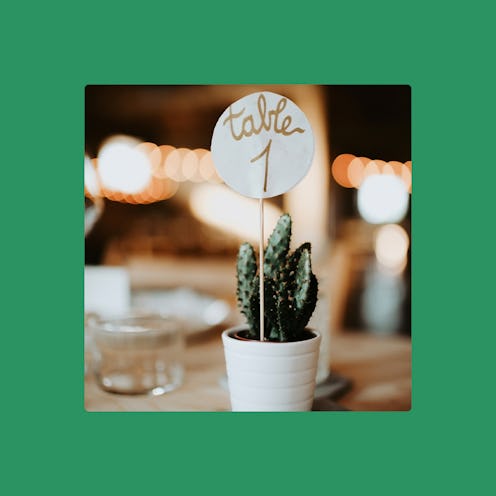The Lazy Girl's Guide To Planning A Wedding
How To Not Cry Over The Table Seating Arrangements At Your Wedding
You'll need a strategy for this one.

You may have wondered: Do I need a seating chart? This is one of those “is this a big deal” questions that actually can be pretty important if you have more than 20 or so guests. “I didn’t think about it until a few hours beforehand, and boy, was everyone mad at me. It was a hot mess,” says Judy, 37, from Queens, New York. Luckily, seating charts also aren’t one of those things that have to be overinvolved. But having a strategy can help your guests avoid awkward moments and can actually make the entire evening go more smoothly.
When Should You Actually Start Planning Your Table Seating?
Once RSVPs come in is when you can begin the seating charts, but keep in mind you may want to keep things flexible with room to swap people in and out. It also depends on your vision for seating: Place cards (which have your guest’s name, table number, and seat assignment) are less forgiving than escort cards, which simply have your guest’s name and table number, says Liz Curtis, founder and CEO of Table + Teaspoon, a tabletop and tablescape rental service. If you’re getting place cards printed, you’ll need at least two weeks prior to the wedding to lock in the guest list and the seating, but that’s not counting the time and energy it takes to figure out where everyone is going to sit.
Choosing actual seats for each guest, as opposed to a table assignment, is a time suck to consider. “Though it’s lovely for your guests to feel like their seat was personally picked by the bride and groom, the amount of stress that goes into collecting information from your soon-to-be spouse, their parents, and your parents about every single guest in order to place them is overwhelming,” says Curtis. Instead, you could just focus on table assignments via place cards. By 72 hours before the event, your seating chart should be “locked” — but know that you may need to do one or two switches prior to the actual reception.
If you want to avoid printing and keeping track of cards for every single guest, consider printing a seating chart board. This way, everyone can glance at the board before they head into the reception to find out their table number and they won’t need to take anything with them. Though, with a board, any major last-minute switches might be more difficult.
How It Worked IRL
It’s important to think about your guests when you assign tables — a lot of couples like to put elderly relatives toward the perimeter, so they can easily excuse themselves to the restroom and they’re not blasted with music from the dance floor — but don’t overthink it. Camille, 31, who lives in Brooklyn, New York, made the table seating planning process simple. “I went to a wedding where a friend purposely mixed tables to have her friends meet new people with somewhat common interests. I hated it,” Camille says. “I just wanted to sit with the people I already knew. So for my wedding I put together people who knew each other and if there weren’t enough to fill a table, put them with people of a similar demographic or age.”
And know that seating is just one of those things that may have some day-of hiccups. “The seating changes at the last minute, so be prepared for that,” says Laura, 33, from Basking Ridge, New Jersey, who added that she brought blank seating cards so they could be filled in on the day of her wedding.
The Best Hacks To Cut The Hassle
If your mom or your partner’s dad has a lot of opinions on who sits where, let them — and allow them to take control of seating the relatives and their friends, while you focus on your friends. That’s why using a program online can help. Curtis recommends AllSeated and StyleMePretty, which can allow multiple people to log in and work through assignments in real time. Also, to make planning your tables easier, consider having different table sizes.
Experts:
Liz Curtis, founder and CEO of Table + Teaspoon, a tabletop and tablescape rental service
This article was originally published on